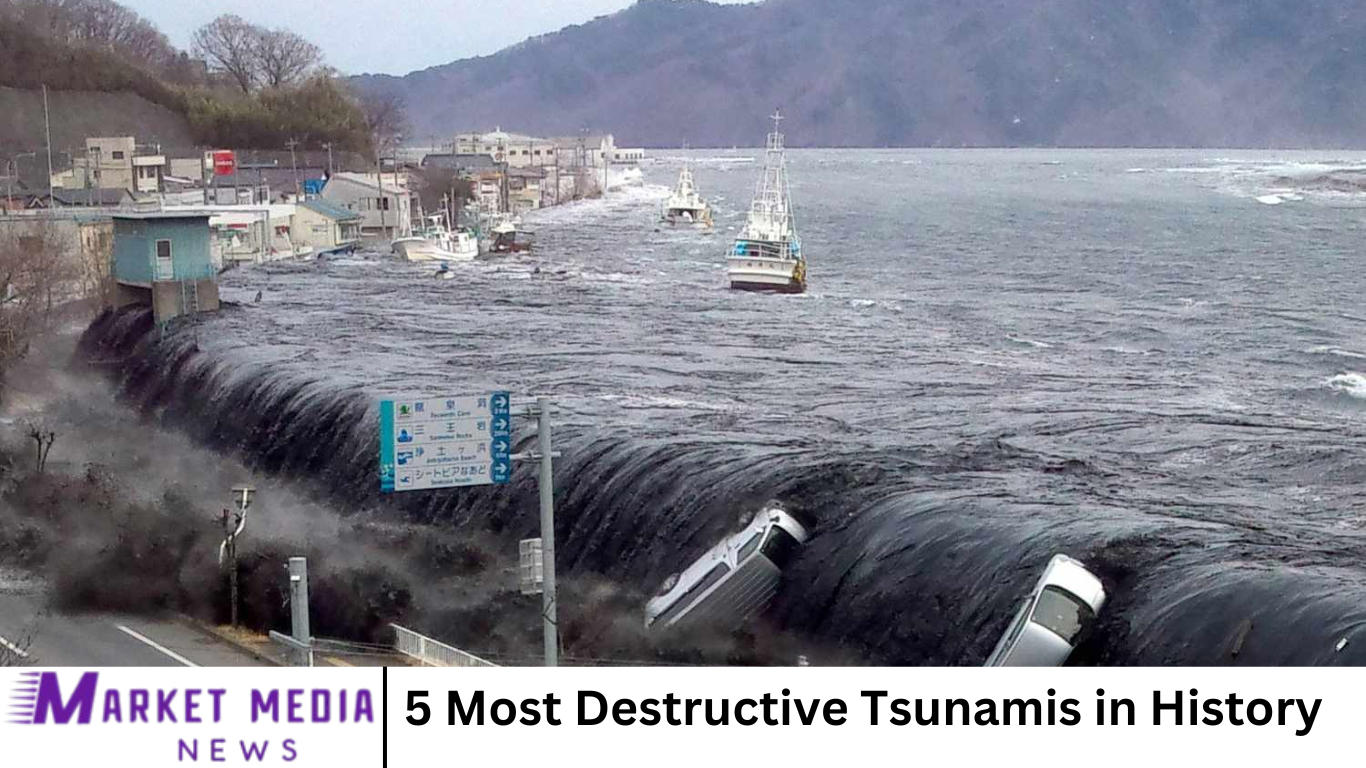Hi everyone! How are you all doing? Welcome to marketmedianews.com! Tsunamis are among the most powerful and devastating natural disasters known to humanity. These massive waves, often triggered by undersea earthquakes, volcanic eruptions, or landslides, can cause widespread destruction and loss of life. Throughout history, several tsunamis have left indelible marks on the world, reshaping coastlines and communities. This article delves into five of the most catastrophic tsunamis ever recorded, examining their causes, impacts, and the lessons learned.
The 2004 Indian Ocean Tsunami
Date: December 26, 2004
Magnitude: 9.1–9.3
Death Toll: Approximately 227,898 people
The 2004 Indian Ocean tsunami stands as the deadliest in recorded history. Triggered by a massive undersea earthquake off the coast of Sumatra, Indonesia, the tsunami affected 14 countries, including Thailand, Sri Lanka, India, and the Maldives. The waves reached heights of up to 30 meters (100 feet), inundating coastal regions and causing widespread devastation.
The disaster highlighted the vulnerability of the Indian Ocean region, which lacked a comprehensive tsunami warning system at the time. In the aftermath, international efforts led to the establishment of the Indian Ocean Tsunami Warning System, aiming to provide early alerts and reduce the risk of future tragedies.
The 2011 Tōhoku Tsunami
Date: March 11, 2011
Magnitude: 9.0
Death Toll: Over 15,000 people
On March 11, 2011, a powerful earthquake struck off the coast of Japan, generating a massive tsunami that devastated the northeastern region of the country. The waves reached heights of up to 40 meters (130 feet), sweeping away entire towns and causing extensive damage to infrastructure.
The tsunami also triggered the Fukushima Daiichi nuclear disaster, as the waves disabled the power supply and cooling systems of three reactors, leading to nuclear meltdowns. The event raised global awareness about the risks associated with nuclear power plants located in seismically active regions.
The 1755 Lisbon Tsunami
Date: November 1, 1755
Magnitude: Estimated at 8.5–9.0
Death Toll: Estimated between 60,000 and 100,000 people
The 1755 Lisbon earthquake and tsunami were among the most significant natural disasters in European history. Striking on All Saints’ Day, the earthquake devastated Lisbon, and the subsequent tsunami struck the Portuguese coast, causing widespread destruction. The event profoundly impacted European thought, influencing philosophical and theological debates about the nature of disasters and human suffering.
The 1883 Krakatoa Tsunami
Date: August 27, 1883
Magnitude: Estimated at 6.0–6.5 (Volcanic Explosivity Index)
Death Toll: Estimated between 36,000 and 120,000 people
The eruption of Krakatoa in the Sunda Strait between Java and Sumatra was one of the most violent volcanic events in recorded history. The explosion generated tsunamis with waves reaching heights of up to 30 meters (100 feet), causing widespread destruction along the coasts of Java and Sumatra. The eruption also released massive amounts of ash into the atmosphere, leading to global climatic effects, including cooler temperatures and vivid sunsets observed worldwide.
The 1953 North Sea Flood
Date: January 31, 1953
Magnitude: Not applicable (storm surge)
Death Toll: Approximately 1,836 people
The 1953 North Sea flood was a devastating storm surge that affected the coasts of the Netherlands, Belgium, and the United Kingdom. A combination of high spring tides and a severe European windstorm caused the sea to surge over sea defenses, flooding large areas of land. The disaster led to significant loss of life and prompted extensive improvements in flood defense systems in the affected countries.
Frequently Asked Question
What causes a tsunami?
A tsunami is typically caused by undersea earthquakes, volcanic eruptions, or landslides that displace a large volume of water. This displacement generates waves that travel across the ocean at high speeds and can cause significant damage when they reach coastal areas.
How fast do tsunami waves travel?
Tsunami waves can travel at speeds of up to 500 to 800 kilometers per hour (310 to 500 miles per hour) in deep water. As they approach shallow coastal areas, their speed decreases, but their height increases, leading to the potential for significant destruction.
Can tsunamis be predicted?
While scientists have made significant advancements in understanding and detecting tsunamis, predicting the exact time and location of a tsunami remains challenging. Early warning systems have been developed in some regions to provide alerts, but these systems are not foolproof.
What is the difference between a tsunami and a tidal wave?
The term “tidal wave” is a misnomer and is often used interchangeably with “tsunami.” However, tsunamis are not related to tides; they are caused by sudden displacements of water due to seismic activity or other events.
How can communities prepare for a tsunami?
Communities can prepare for tsunamis by developing and implementing tsunami evacuation plans, educating residents about warning signs, and investing in early warning systems. Coastal infrastructure should also be designed to withstand potential tsunami impacts.
Are tsunamis common?
Tsunamis are relatively rare events, but they can occur anywhere in the world, especially in regions near tectonic plate boundaries. The Pacific Ocean’s “Ring of Fire” is particularly susceptible to seismic activity that can generate tsunamis.
What should you do if you are near the coast during a tsunami warning?
If you are near the coast during a tsunami warning, move to higher ground immediately. Avoid driving, as roads may be congested or damaged. Stay tuned to emergency broadcasts for updates and follow the instructions of local authorities.
Conclusion
Tsunamis are formidable natural disasters that have shaped human history through their immense power and devastating effects. The five tsunamis discussed in this article serve as stark reminders of the forces of nature and the importance of preparedness and resilience in the face of such events. Through continued research, education, and international cooperation, societies can better mitigate the impacts of future tsunamis and protect vulnerable populations.

